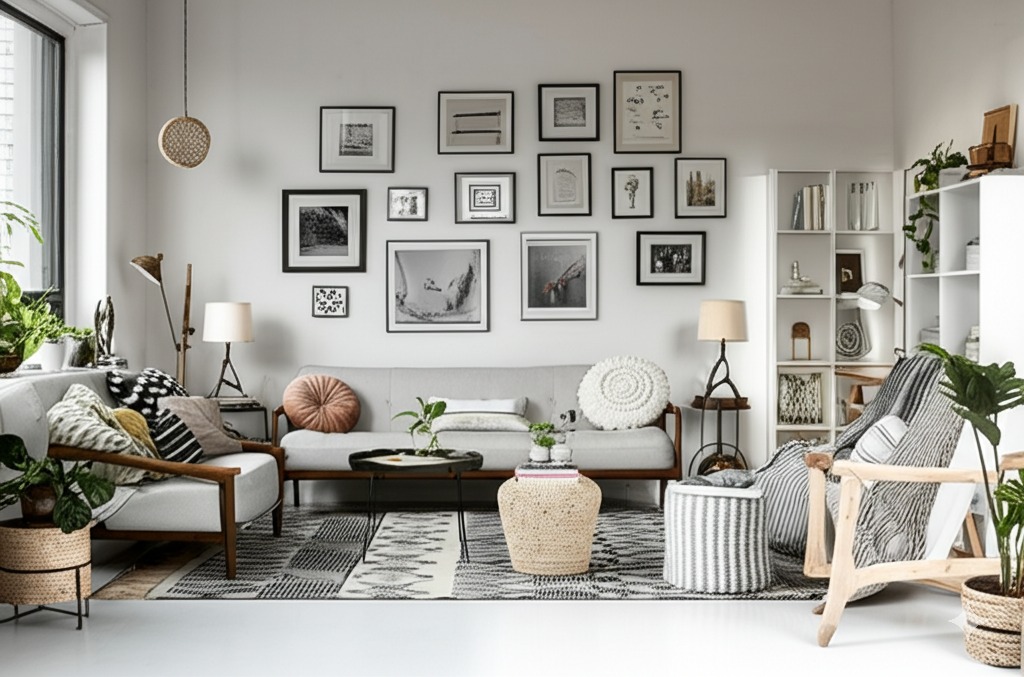Shared spaces—like living rooms, shared bedrooms, or home offices—require careful thought to balance functionality, personal expression, and comfort. Whether you’re sharing with a roommate, a partner, or family, good design helps ensure that the space feels cohesive, fair, and enjoyable for everyone.
In this guide, you’ll learn how to decorate shared spaces to reflect different tastes and needs—without losing harmony or style.
1. Start with Open Communication
Before choosing furniture or colors, talk to your co-habitants about the space.
What to Discuss:
- Preferred colors and decor styles
- Individual needs (storage, work areas, privacy)
- Budget and responsibilities
- Must-have items or sentimental pieces
Clear communication helps avoid clashes down the road.
2. Choose a Neutral Foundation
Start with a neutral base that appeals to everyone, then add personalized accents.
Best Neutral Base Options:
- Colors: White, beige, gray, or greige walls and floors
- Furniture: Simple lines in neutral upholstery
- Rugs: Subtle patterns or solid tones in soft colors
A neutral backdrop makes it easier to layer in different personalities and styles.
3. Define Individual Zones Within the Shared Space
Giving each person their own “zone” helps maintain personal identity in a shared area.
Ideas to Create Zones:
- Use area rugs to visually separate spaces
- Assign chairs, desks, or shelves to each person
- Set up separate lighting for each zone
- Use room dividers or bookcases for more privacy
Defined zones reduce tension and make shared living more comfortable.
4. Blend Decorating Styles for a Balanced Look
When two styles meet—say, modern and bohemian—it’s all about blending, not matching.
Style Harmony Tips:
- Choose a common color palette to tie elements together
- Mix textures (e.g., velvet + wood, metal + rattan)
- Alternate between both styles (e.g., modern sofa with boho throw pillows)
- Find compromise pieces that reflect both personalities
When done right, style blending results in a more unique and layered design.
5. Use Symmetry for a Sense of Balance
In shared spaces, symmetry brings order and visual calm.
How to Use Symmetry:
- Pair armchairs, lamps, or nightstands
- Arrange furniture to create balance in layout
- Use matching shelves or bins for each person’s belongings
Balanced design makes shared spaces feel more harmonious.
6. Personalize with Shared and Individual Decor
Let everyone contribute to the space while keeping it cohesive.
Ideas for Personalization:
- A shared gallery wall with photos or art from both people
- Personal shelves, cork boards, or framed prints in each person’s area
- A mix of books, travel souvenirs, or hobbies on display
Decorate together to reflect shared memories and individual interests.
7. Maximize Storage to Prevent Clutter
In shared areas, clutter builds up fast—smart storage is a must.
Best Storage Solutions:
- Storage ottomans, under-bed bins, or double-duty furniture
- Labelled baskets or boxes for each person
- Shared closet or wardrobe organizers
- Floating shelves to free up floor space
Clear surfaces and accessible storage create peace in shared living.
8. Choose Multipurpose Furniture
Flexible furniture makes shared spaces more adaptable.
Top Picks for Shared Areas:
- Sleeper sofas or daybeds for extra guests
- Nesting tables that can be moved or tucked away
- Drop-leaf or expandable dining tables
- Modular shelving that grows with your needs
Multipurpose furniture helps everyone get what they need from the space.
9. Add Greenery for a Shared Connection to Nature
Plants help create a calming, inviting space for everyone.
Easy Shared Space Plants:
- Snake plant or pothos (low maintenance)
- Peace lily or ZZ plant for air purification
- Shared herb garden on the windowsill
Caring for plants together can even become a bonding experience.
10. Keep It Flexible and Evolving
Tastes change, and so do living situations—leave room for growth.
How to Stay Adaptable:
- Use removable decor like peel-and-stick wallpaper or art prints
- Rearrange furniture seasonally for a fresh feel
- Revisit storage and function as routines change
- Celebrate progress together and adjust when needed
Shared living is dynamic—so your space should evolve with it.
Final Thoughts
Decorating a shared space is about balance, respect, and creativity. By blending styles, setting clear zones, choosing neutral foundations, and incorporating personal touches, you can design a space that feels harmonious and welcoming for everyone involved.
When everyone feels seen, the space feels like home. 🛋️🧑🤝🧑✨
